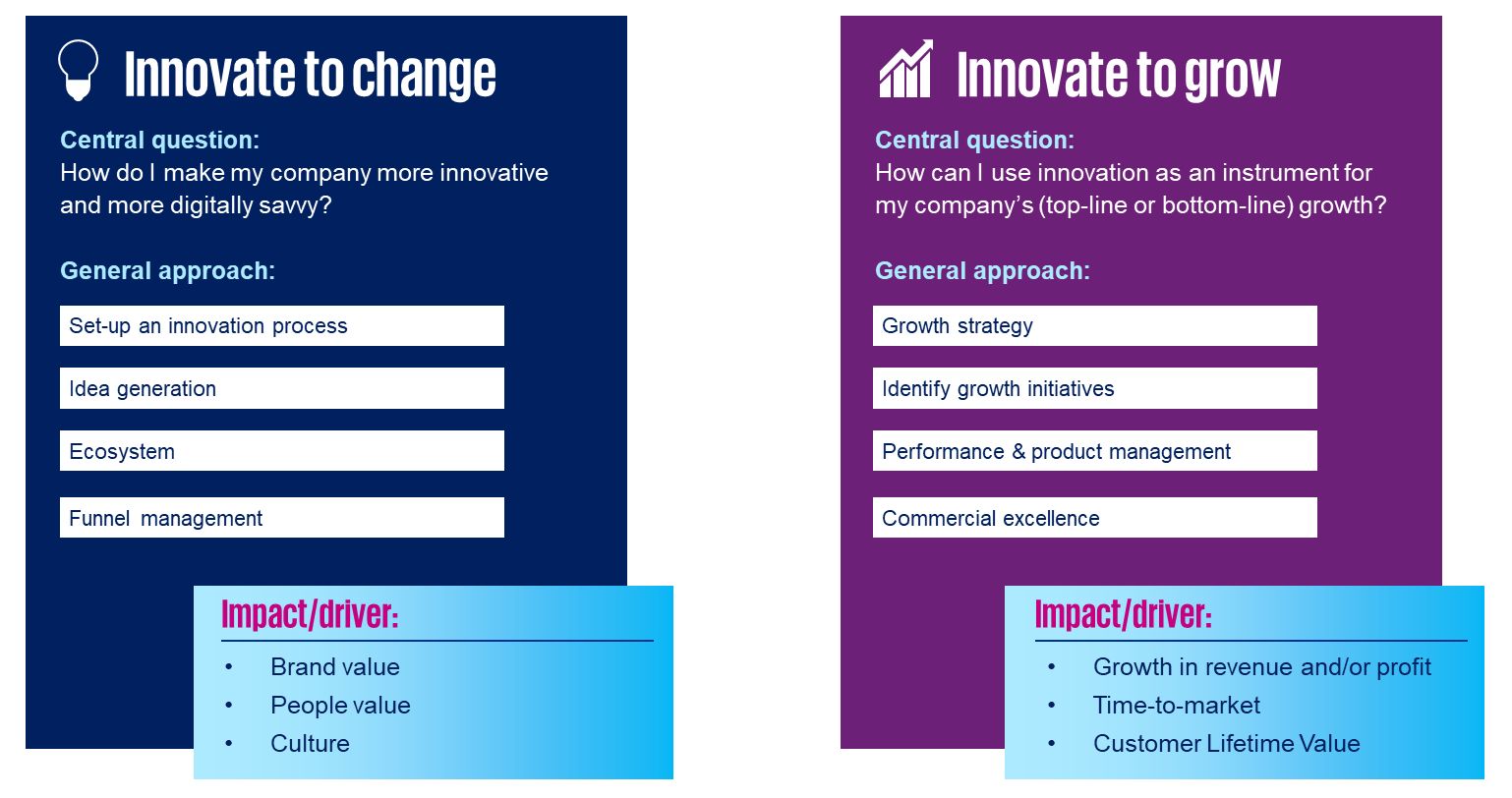Recently, Steve Blank, a well-known serial entrepreneur and celebrated innovation author at Stanford, turned to CTOs with questions about finding and growing the innovation islands within the company during the first six months. In his post on LinkedIn, he addressed the first months of a new CTO at a large company (30.000+ people) who in his role was also responsible for the innovation agenda. With a background, mainly, at software startups, the new CTO experienced many challenges of corporate innovation very quickly:
- Centralised vs de-centralised innovation: what is happening where and how to keep control over all our innovation efforts?
- Innovation legacy: what has happened in the past and did we actually document our learnings? How do I make sure that I do not reinvent the wheel and encounter the same pitfalls?
- What is the actual underlying goal here: are we innovating to shape our culture and get great press, or do we really want to create an impact on our business, clients, and results?
Focus on the islands of innovation that can put wins on the board
At the end of the post, Blank’s key question remains: How do you quickly infiltrate a large, complex company of that size? How do you put wins on the board and get a coalition working?
- Firstly, we need to find the level of dependency on ‘innovation heroes’ to discover if we are dealing with a dysfunctional organisation: innovation heroes are the individuals that others in the company point to, who single-handedly fights the system and gets a new product, project or service delivered. They are not scalable, can walk out of the building at every moment and show that there are no clear structures and playbooks in place at scale.
- Secondly, the new CTO’s insight was that he needed to get out of his eighth floor office and spend time in the department where his company’s products and services were being developed and delivered, to the clients (as Blank always says: “get out the building, there are no facts inside”). If innovation was previously done correctly, it is likely that those innovative groups are not only talking about innovation but are the ones that rapidly deliver innovative solutions to customer’s needs.
The reality is, however, that most innovations (e.g., new products or business models) do not end up being delivered to actual customers, let alone rapidly. After years of adopting methodologies like the Lean Start-up and Agile Scrum, large incumbents still struggle daily to get innovation into the market, leaving vast amounts of untapped potential on the shelf. Why does this remain the case? Mainly, because they still struggle to get a standardised, dedicated, and structured approach in place to continuously keep the focus on delivering value faster to the client.
This conclusion is supported by research performed by Simon Kuger Consulting, saying that 72% of all new products do not meet their revenue targets.
“Having great new technologies and products certainly doesn’t guarantee immediate returns. This shows that the difficult part of innovation is creating value propositions that resonate with customers and finding the right business models for profitability.”
This challenge for the CTO has been perfectly described as the balance between ‘innovation capacity’ and ‘innovation ability’ in the Harvard Business review article: The Right Way to Spend Your Innovation Budget.
Trade-off: Innovation vs other agendas
Let us not forget the CTO agenda is much larger than just innovation and, therefore, trade-offs might occur. The CTO oversees the current technology and creates relevant policy, aligns technology-related decisions with the organisation's goals, manages IT-related issues, developing, implementing, managing, and evaluating the company's technology resources to reach the organisation’s short- and long-term goals (‘gasps for breath’). Due to the technology-driven responsibilities of the CTO we see a disbalance towards investment in ‘innovation capacity,’ which in turn might explain the earlier addressed issue of getting products off the shelf (which mostly requires ‘innovation ability’).
Create the right balance between innovation capacity and ability
Delving deeper into innovation capacity, the following can be said: a firm’s innovation capacity is the organiation’s potential for innovation. Innovation capacity is comprised of things like the procurement of modern technology, acquiring new talent and buying facilities. From our experience in the market, we estimate that roughly 75% of the innovation budgets are allocated to innovation capacity. On a positive note, investing in innovation capacity creates a solid foundation for future product development and eases sustainable growth, so a certain level of innovation capacity is needed. The dark side of innovation capacity encompasses the phenomenon that innovation capacity does not directly result in enhanced business or client value. Along the same lines, firms are often unable to measure the impact or success of innovation capacity. Furthermore, upfront investments are often high and are only beneficial to economies of scale.
In contrast to innovation capacity, innovation ability is the degree in which a firm exploits the innovation capacity. Innovation ability entails value creation in various aspects like creating new customer experiences, new business models and creating value in the service system. Focusing on innovation ability allows an organisation to get a better understanding of the market through client feedback. By acting upon the customer feedback, customer needs and market demand can be fulfilled, value is created, and customer experiences are improved. As a result, a product-market fit can be found, leading a company to experience market pull instead of market push. The enactment of these processes fuels the firm’s commercial results, which in turn drives change and support from stakeholders. However, reality tells us that companies only spend 25% of their innovation budget to improve their innovation ability and, therefore, do not optimally reap the benefits of innovation ability.
Make sure to have an unambiguous goal: innovate to change or grow
Besides having a good balance of innovation ability versus innovation capability, CTOs need to overcome another challenge, the goals and preferred outcomes of innovation within the larger growth strategy. Apart from their own ambitions and view of the current market circumstances, CTO’s need to create clarity in the boardroom on what the innovation goals are and which outcomes the company is steering for. Is the CTO able to match the company's innovation efforts with the agendas of the CEO (e.g., commercial & future growth) and CFO (e.g., limiting financial risk and optimizing margins).
Too often we see that great effort has been put into building an innovation culture, processes, ideation, and innovation ecosystems while down the line the CEO and CFO are looking for tangible results, affecting top- and bottom-line. Besides that, we see that the earlier mentioned (de-centralized) islands of innovation might have the tendency to drift off and pivot away from the boardroom's growth strategy due to perceived new market demands and opportunistic behavior to please and win their first clients. Those pivots are famously celebrated by the innovation handbook, but the innovation no longer fits the company's strategy.
Both risks will occur if we do not have a clear consensus of the innovation goals and the ability to connect our day-to-day operational innovation efforts to this goal. Let us, therefore, constantly iterate on the question whether we are innovating to change or innovating to grow.

In conclusion:
Innovation is still an ongoing concern and requires constant energy and focus from the CTO. In an era of digital transformation and unlimited technological possibilities, this has not become any easier for their already packed agenda. Although there is much more to learn, a few take-aways might help to structure the agenda for the coming period:
- Focus on the islands of innovation that can put wins on the board
- Create the right balance between innovation capacity and ability
- Make sure to have an unambiguous goal: innovate to change or grow
Would you like to learn more about how we enable innovation to be instrumental to the company’s growth agenda?
Do not hesitate to reach out for an open discussion or read our latest publication about our New Growth Realization framework.
Discover more
Contact us
Senior Manager, Strategy & Innovation
KPMG in the Netherlands
Manager, Strategy & Innovation
KPMG in the Netherlands

We will keep you informed by email.
Enter your preferences here.



